Accuracy of a Method to Monitor Root Position Using a 3D Digital Crown/Root Model during Orthodontic Treatments
Abstract
:1. Introduction
2. Materials and Methods
2.1. Data Collection
2.2. Fabrication of 3D Digital Crown/Root Models (3DCRM)
2.3. Test Method to Predict the Post-Treatment Root Position
2.4. Current Method to Identify the Post-Treatment Root Position
2.5. Analysis of Accuracy for Prediction of Post-Movement Root Position and Statistical Analysis
- Color displacement map
- 3D coordinate assessment of the discrepancy in six directions.
- Association between the accuracy of the test method and the amount of actual root apex movement.
3. Results
3.1. Displacement on the Color Map
3.2. Discrepancy Based on 3D Coordinates
3.3. Association
4. Discussion
5. Conclusions
Author Contributions
Funding
Institutional Review Board Statement
Informed Consent Statement
Data Availability Statement
Acknowledgments
Conflicts of Interest
References
- Andrews, L.F. The six keys to normal occlusion. Am. J. Orthod. 1972, 62, 296–309. [Google Scholar] [CrossRef]
- Balut, N.; Klapper, L.; Sandrik, J.; Bowman, D. Variations in bracket placement in the preadjusted orthodontic appliance. Am. J. Orthod. Dentofac. Orthop. Off. Publ. Am. Assoc. Orthod. Const. Soc. Am. Board Orthod. 1992, 102, 62–67. [Google Scholar] [CrossRef] [Green Version]
- Dewel, B.F. Clinical observations on the axial inclination of teeth. Am. J. Orthod. 1949, 35, 98–115. [Google Scholar] [CrossRef]
- Vermylen, K.; De Quincey, G.N.; van‘t Hof, M.A.; Wolffe, G.N.; Renggli, H.H. Classification, reproducibility and prevalence of root proximity in periodontal patients. J. Clin. Periodontol. 2005, 32, 254–259. [Google Scholar] [CrossRef] [PubMed]
- Vermylen, K.; De Quincey, G.N.; Wolffe, G.N.; van’t Hof, M.A.; Renggli, H.H. Root proximity as a risk marker for periodontal disease: A case-control study. J. Clin. Periodontol. 2005, 32, 260–265. [Google Scholar] [CrossRef]
- Olsen, C.T.; Ammons, W.F.; van Belle, G. A longitudinal study comparing apically repositioned flaps, with and without osseous surgery. Int. J. Periodontics Restor. Dent. 1985, 5, 10–33. [Google Scholar]
- Waerhaug, J. Eruption of teeth into crowded position, loss of attachment, and downgrowth of subgingival plaque. Am. J. Orthod. 1980, 78, 453–459. [Google Scholar] [CrossRef]
- Nevins, M. Interproximal periodontal disease—The embrasure as an etiologic factor. Int. J. Periodontics Restor. Dent. 1982, 2, 8–27. [Google Scholar]
- Klassman, B.; Zucker, H.W. Treatment of a periodontal defect resulting from improper tooth alignment and local factors. J. Periodontol. 1969, 40, 401–403. [Google Scholar] [CrossRef]
- Ritchey, B.; Orban, B. The crests of the interdental alveolar septa. J. Periodontol. 1953, 24, 75–87. [Google Scholar] [CrossRef]
- Akiyoshi, M.; Mori, K. Marginal periodontitis: A histological study of the incipient stage. J. Periodontol. 1967, 38, 45–52. [Google Scholar] [CrossRef] [PubMed]
- Wennstrom, J.L. Mucogingival considerations in orthodontic treatment. Semin. Orthod. 1996, 2, 46–54. [Google Scholar] [CrossRef]
- Steiner, G.G.; Pearson, J.K.; Ainamo, J. Changes of the marginal periodontium as a result of labial tooth movement in monkeys. J. Periodontol. 1981, 52, 314–320. [Google Scholar] [CrossRef] [PubMed]
- Patel, S.; Brown, J.; Pimentel, T.; Kelly, R.D.; Abella, F.; Durack, C. Cone beam computed tomography in Endodontics—A review of the literature. Int. Endod. J. 2019, 52, 1138–1152. [Google Scholar] [CrossRef] [PubMed] [Green Version]
- Pellegrino, G.; Grande, F.; Ferri, A.; Pisi, P.; Gandolfi, M.G.; Marchetti, C. Three-Dimensional Radiographic Evaluation of the Malar Bone Engagement Available for Ideal Zygomatic Implant Placement. Methods Protoc. 2020, 3, 52. [Google Scholar] [CrossRef]
- Garib, D.G.; Calil, L.R.; Leal, C.R.; Janson, G. Is there a consensus for CBCT use in Orthodontics? Dent. Press J. Orthod. 2014, 19, 136–149. [Google Scholar] [CrossRef] [Green Version]
- Kapila, S.D.; Nervina, J.M. CBCT in orthodontics: Assessment of treatment outcomes and indications for its use. Dento Maxillo Facial Radiol. 2015, 44, 20140282. [Google Scholar] [CrossRef] [Green Version]
- Signorelli, L.; Patcas, R.; Peltomaki, T.; Schatzle, M. Radiation dose of cone-beam computed tomography compared to conventional radiographs in orthodontics. J. Orofac. Orthop. Fortschr. Kieferorthopadie Organ/Off. J. Dtsch. Ges. Fur Kieferorthopadie 2016, 77, 9–15. [Google Scholar] [CrossRef]
- Silva, M.A.; Wolf, U.; Heinicke, F.; Bumann, A.; Visser, H.; Hirsch, E. Cone-beam computed tomography for routine orthodontic treatment planning: A radiation dose evaluation. Am. J. Orthod. Dentofac. Orthop. Off. Publ. Am. Assoc. Orthod. Const. Soc. Am. Board Orthod. 2008, 133, 640.e1–640.e5. [Google Scholar] [CrossRef]
- Othman, A.A.; El-Beialy, A.R.; Fawzy, S.A.; Kandil, A.H.; El-Bialy, A.M.; Mostafa, Y.A. Methods for managing 3-dimensional volumes. Am. J. Orthod. Dentofac. Orthop. 2010, 137, 266–273. [Google Scholar] [CrossRef]
- Schulze, R.; Heil, U.; Gross, D.; Bruellmann, D.D.; Dranischnikow, E.; Schwanecke, U.; Schoemer, E. Artefacts in CBCT: A review. Dento Maxillo Facial Radiol. 2011, 40, 265–273. [Google Scholar] [CrossRef] [PubMed] [Green Version]
- Kang, S.J.; Kee, Y.J.; Clara Lee, K. Effect of the presence of orthodontic brackets on intraoral scans. Angle Orthod. 2021, 91, 98–104. [Google Scholar] [CrossRef] [PubMed]
- Jung, Y.R.; Park, J.M.; Chun, Y.S.; Lee, K.N.; Kim, M. Accuracy of four different digital intraoral scanners: Effects of the presence of orthodontic brackets and wire. Int. J. Comput. Dent. 2016, 19, 203–215. [Google Scholar] [PubMed]
- Lee, R.J.; Pham, J.; Choy, M.; Weissheimer, A.; Dougherty, H.L., Jr.; Sameshima, G.T.; Tong, H. Monitoring of typodont root movement via crown superimposition of single cone-beam computed tomography and consecutive intraoral scans. Am. J. Orthod. Dentofac. Orthop. Off. Publ. Am. Assoc. Orthod. Const. Soc. Am. Board Orthod. 2014, 145, 399–409. [Google Scholar] [CrossRef] [PubMed]
- Keim, R.G.; Gottlieb, E.L.; Nelson, A.H.; Vogels, D.S., 3rd. 2008 JCO study of orthodontic diagnosis and treatment procedures, part 1: Results and trends. J. Clin. Orthod. JCO 2008, 42, 625–640. [Google Scholar]
- Yim, J.H.; Ryu, D.M.; Lee, B.S.; Kwon, Y.D. Analysis of digitalized panorama and cone beam computed tomographic image distortion for the diagnosis of dental implant surgery. J. Craniofacial Surg. 2011, 22, 669–673. [Google Scholar] [CrossRef]
- Isaacson, K.G.; Thom, A.R.; Atack, N.E.; Horner, K.; Whaites, E. Guidelines for the Use of Radiographs in Clinical Orthodontics, 4th ed.; British Orthodontic Society: London, UK, 2015. [Google Scholar]
- Abdelkarim, A.A. Appropriate use of ionizing radiation in orthodontic practice and research. Am. J. Orthod. Dentofac. Orthop. Off. Publ. Am. Assoc. Orthod. Const. Soc. Am. Board Orthod. 2015, 147, 166–168. [Google Scholar] [CrossRef]
- Baumrind, S.; Korn, E.L.; Boyd, R.L. Apical root resorption in orthodontically treated adults. Am. J. Orthod. Dentofac. Orthop. Off. Publ. Am. Assoc. Orthod. Const. Soc. Am. Board Orthod. 1996, 110, 311–320. [Google Scholar] [CrossRef]
- Weiland, F. Constant versus dissipating forces in orthodontics: The effect on initial tooth movement and root resorption. Eur. J. Orthod. 2003, 25, 335–342. [Google Scholar] [CrossRef]
- Taithongchai, R.; Sookkorn, K.; Killiany, D.M. Facial and dentoalveolar structure and the prediction of apical root shortening. Am. J. Orthod. Dentofac. Orthop. Off. Publ. Am. Assoc. Orthod. Const. Soc. Am. Board Orthod. 1996, 110, 296–302. [Google Scholar] [CrossRef]
- Paetyangkul, A.; Turk, T.; Elekdag-Turk, S.; Jones, A.S.; Petocz, P.; Cheng, L.L.; Darendeliler, M.A. Physical properties of root cementum: Part 16. Comparisons of root resorption and resorption craters after the application of light and heavy continuous and controlled orthodontic forces for 4, 8, and 12 weeks. Am. J. Orthod. Dentofac. Orthop. Off. Publ. Am. Assoc. Orthod. Const. Soc. Am. Board Orthod. 2011, 139, e279–e284. [Google Scholar] [CrossRef] [PubMed]
- Maltha, J.C.; van Leeuwen, E.J.; Dijkman, G.E.; Kuijpers-Jagtman, A.M. Incidence and severity of root resorption in orthodontically moved premolars in dogs. Orthod. Craniofacial Res. 2004, 7, 115–121. [Google Scholar] [CrossRef] [PubMed]
- Stenvik, A.; Mjor, I.A. Pulp and dentine reactions to experimental tooth intrusion. A histologic study of the initial changes. Am. J. Orthod. 1970, 57, 370–385. [Google Scholar] [CrossRef]
- Currell, S.D.; Liaw, A.; Blackmore Grant, P.D.; Esterman, A.; Nimmo, A. Orthodontic mechanotherapies and their influence on external root resorption: A systematic review. Am. J. Orthod. Dentofac. Orthop. Off. Publ. Am. Assoc. Orthod. Const. Soc. Am. Board Orthod. 2019, 155, 313–329. [Google Scholar] [CrossRef] [PubMed]
- Ahangari, Z.; Nasser, M.; Mahdian, M.; Fedorowicz, Z.; Marchesan, M.A. Interventions for the management of external root resorption. Cochrane Database Syst. Rev. 2015, 2015, Cd008003. [Google Scholar] [CrossRef]
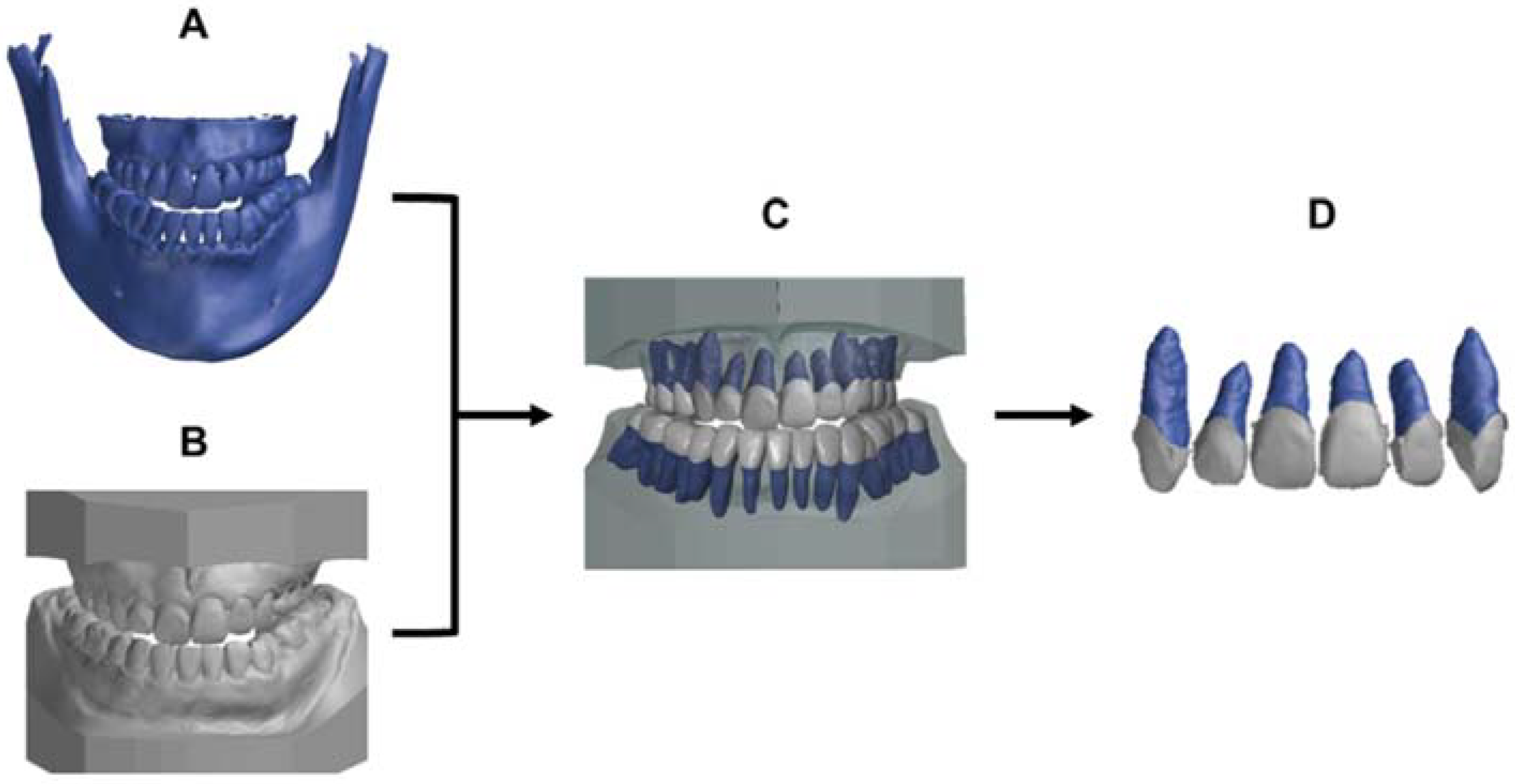
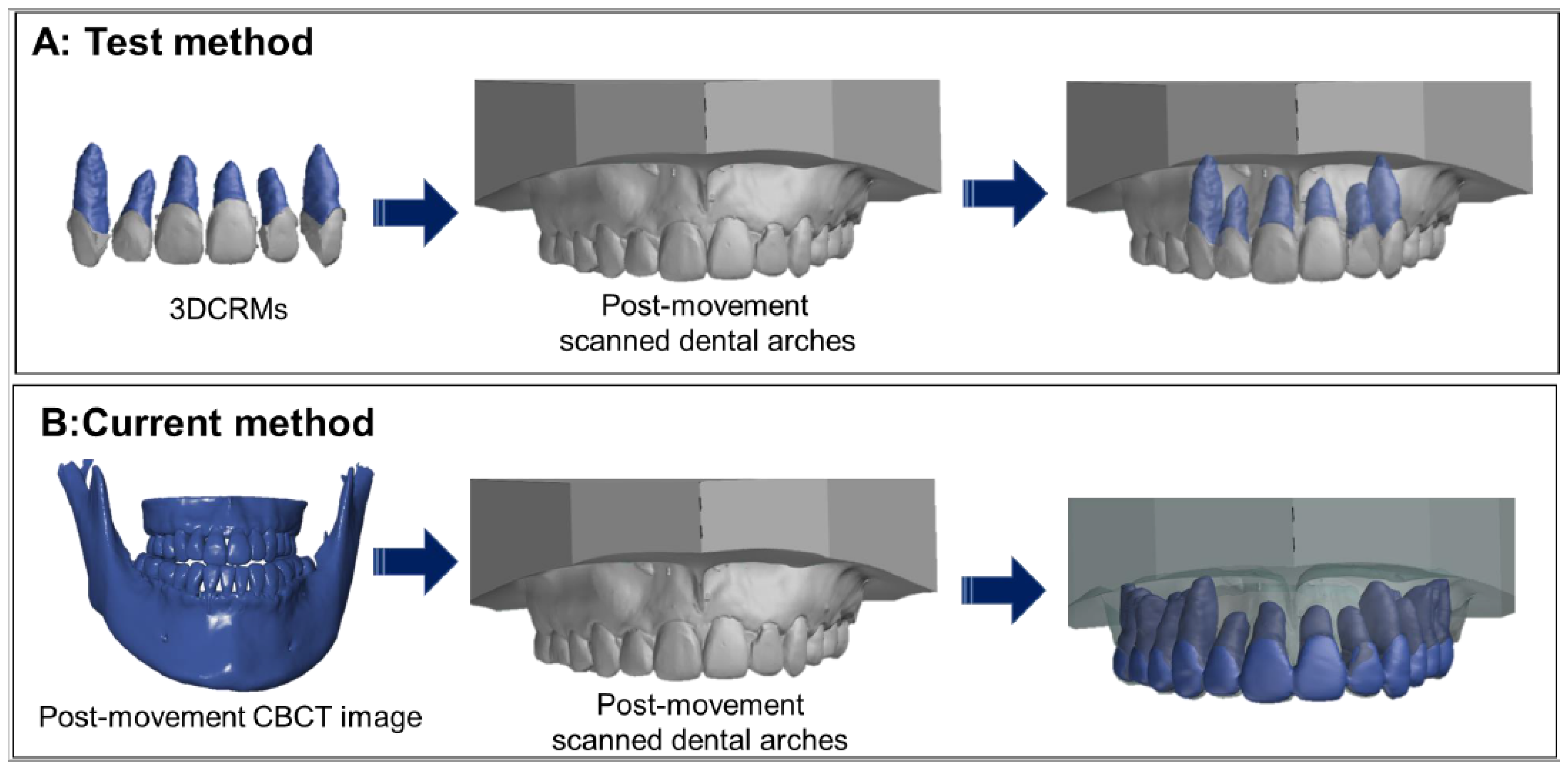
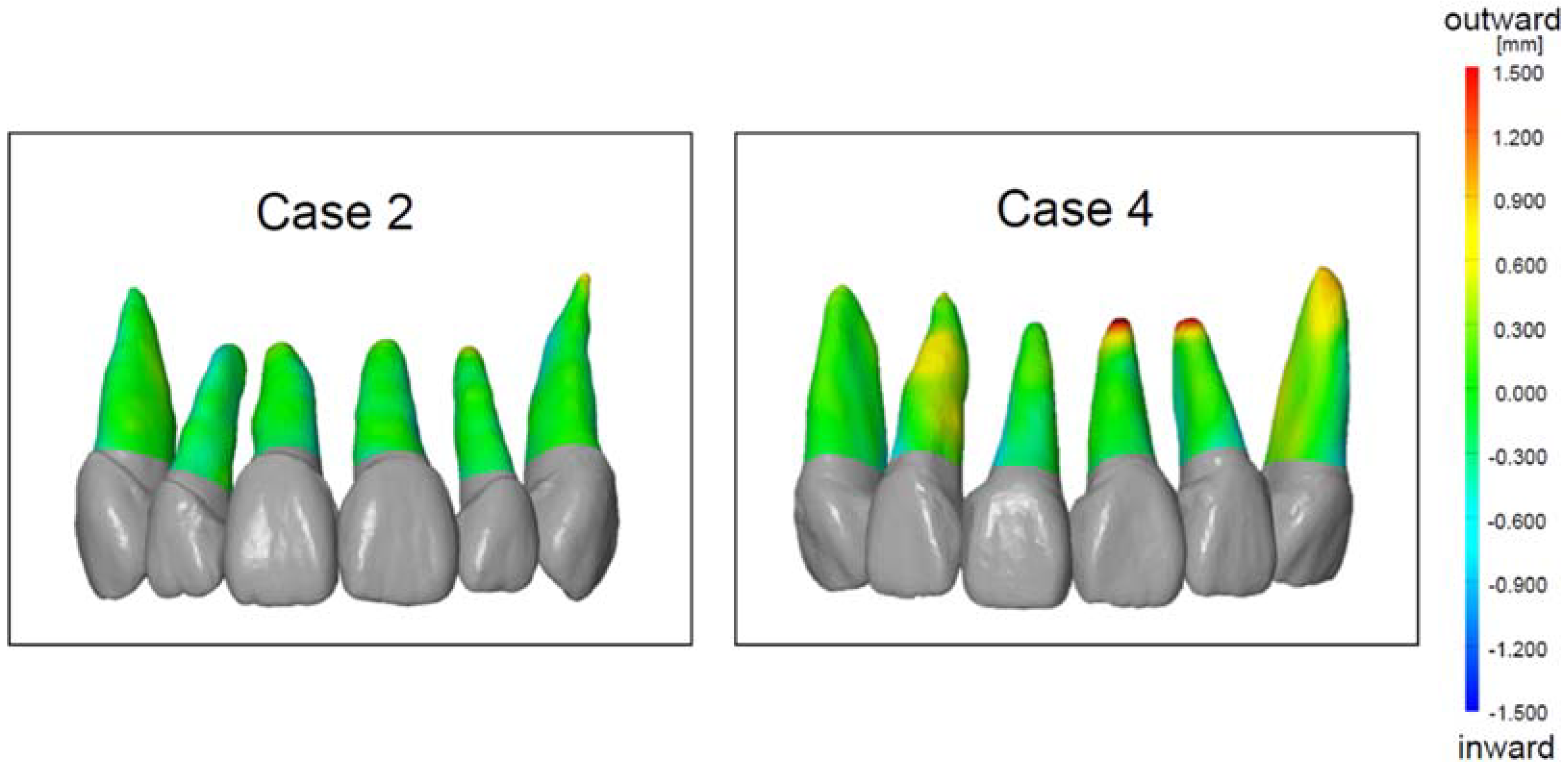
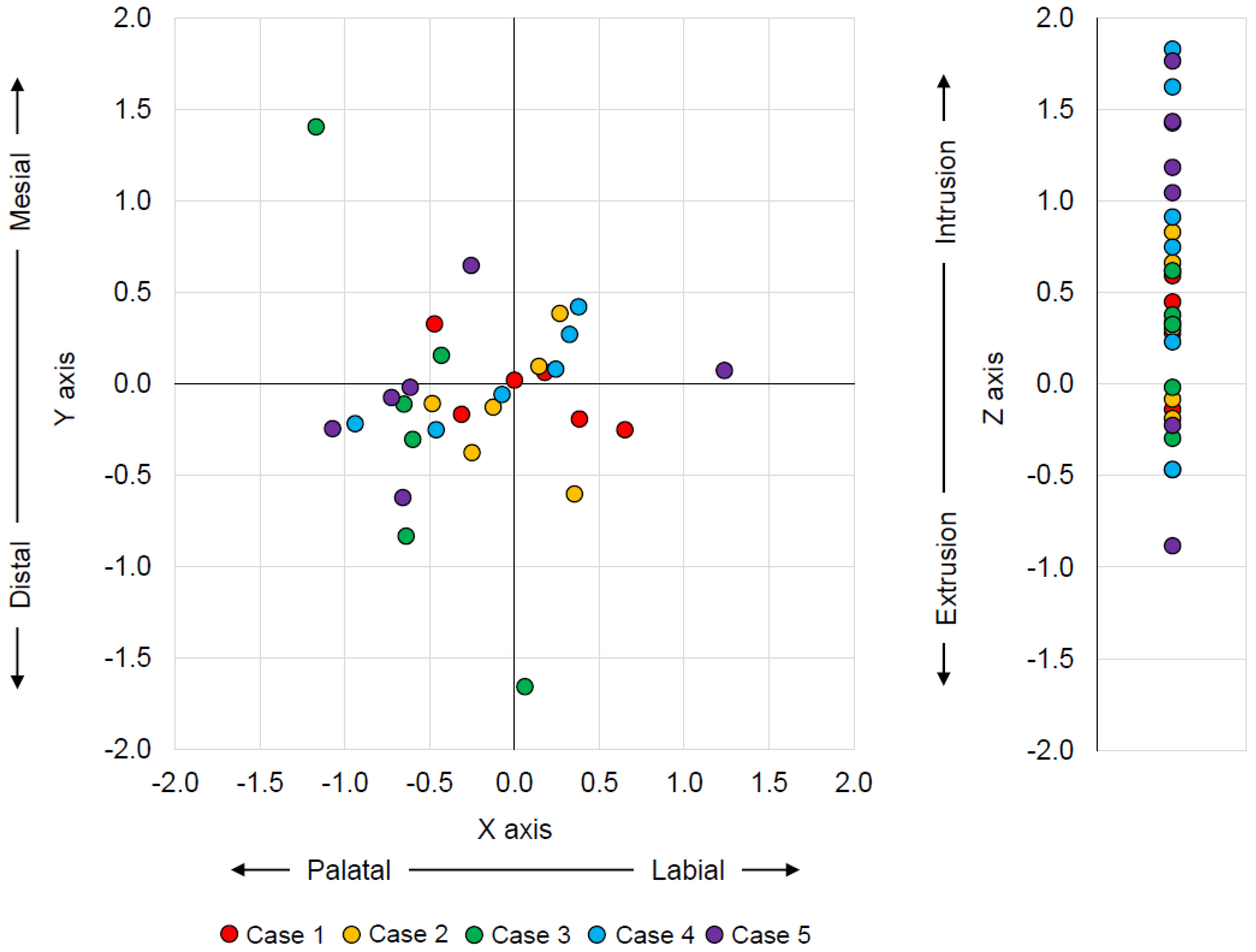
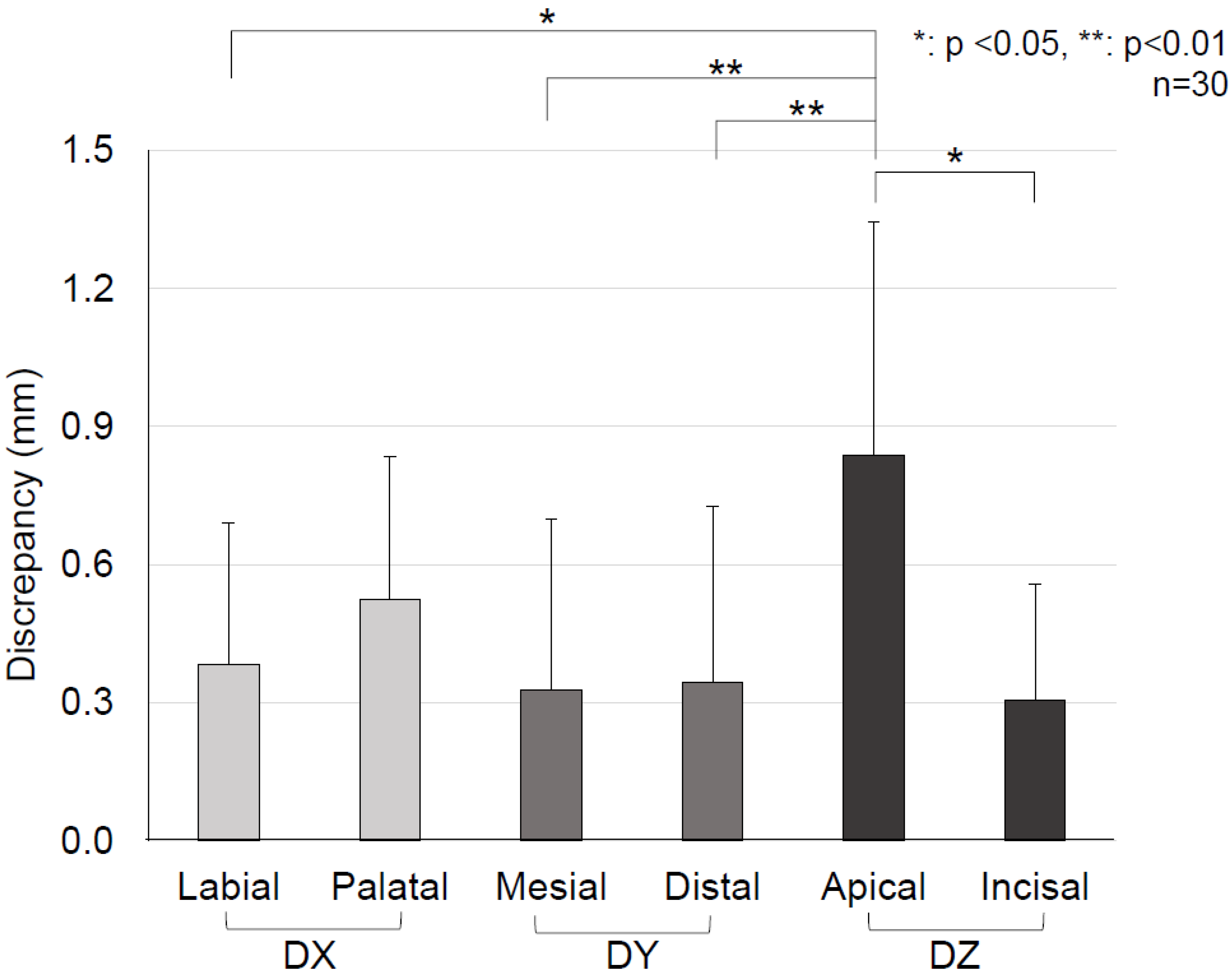
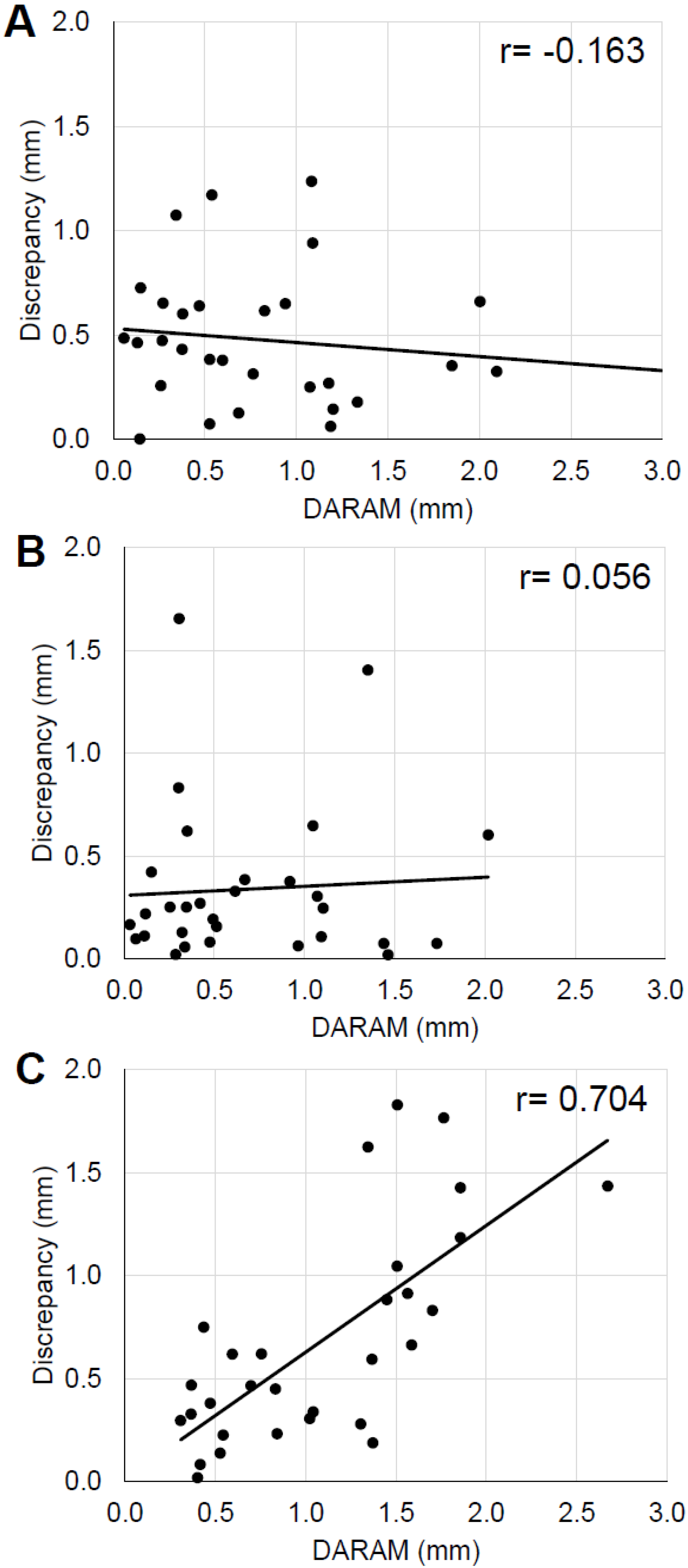
| Average | S.D. | Max. | Min. | |
|---|---|---|---|---|
| Total | −0.165 | ±0.053 | 1.889 | −1.222 |
| Central incisor | −0.140 | ±0.102 | 1.889 | −1.222 |
| Lateral incisor | −0.136 | ±0.122 | 1.878 | −1.000 |
| Canine | −0.177 | ±0.124 | 1.516 | −1.055 |
| Discrepancy | Central Incisor | Lateral Incisor | Canine | ||||
|---|---|---|---|---|---|---|---|
| Axis | Direction | Mean (SD) | n | Mean (SD) | n | Mean (SD) | n |
| X axis | Palatal | 0.63 (0.38) | 6 | 0.46 (0.28) | 10 | 0.51 (0.18) | 3 |
| Labial | 0.48 (0.44) | 4 | NA | 0 | 0.33 (0.16) | 7 | |
| Y axis | Distal | 0.18 (0.06) | 5 | 0.24 (0.27) | 7 | 0.61 (0.50) | 6 |
| Mesial | 0.41 (0.51) | 5 | 0.17 (0.13) | 3 | 0.35 (0.21) | 4 | |
| Z axis | Incisal | 0.27 (0.19) | 2 | 0.21 (0.02) | 2 | 0.36 (0.30) | 5 |
| Apical | 0.92 (0.61) | 8 | 0.83 (0.47) | 8 | 0.72 (0.32) | 5 | |
Publisher’s Note: MDPI stays neutral with regard to jurisdictional claims in published maps and institutional affiliations. |
© 2022 by the authors. Licensee MDPI, Basel, Switzerland. This article is an open access article distributed under the terms and conditions of the Creative Commons Attribution (CC BY) license (https://creativecommons.org/licenses/by/4.0/).
Share and Cite
Ogawa, K.; Ishida, Y.; Kuwajima, Y.; Lee, C.; Emge, J.R.; Izumisawa, M.; Satoh, K.; Ishikawa-Nagai, S.; Da Silva, J.D.; Chen, C.-Y. Accuracy of a Method to Monitor Root Position Using a 3D Digital Crown/Root Model during Orthodontic Treatments. Tomography 2022, 8, 550-559. https://doi.org/10.3390/tomography8020045
Ogawa K, Ishida Y, Kuwajima Y, Lee C, Emge JR, Izumisawa M, Satoh K, Ishikawa-Nagai S, Da Silva JD, Chen C-Y. Accuracy of a Method to Monitor Root Position Using a 3D Digital Crown/Root Model during Orthodontic Treatments. Tomography. 2022; 8(2):550-559. https://doi.org/10.3390/tomography8020045
Chicago/Turabian StyleOgawa, Kaho, Yoshiki Ishida, Yukinori Kuwajima, Cliff Lee, Jacob R. Emge, Mitsuru Izumisawa, Kazuro Satoh, Shigemi Ishikawa-Nagai, John D. Da Silva, and Chia-Yu Chen. 2022. "Accuracy of a Method to Monitor Root Position Using a 3D Digital Crown/Root Model during Orthodontic Treatments" Tomography 8, no. 2: 550-559. https://doi.org/10.3390/tomography8020045
APA StyleOgawa, K., Ishida, Y., Kuwajima, Y., Lee, C., Emge, J. R., Izumisawa, M., Satoh, K., Ishikawa-Nagai, S., Da Silva, J. D., & Chen, C.-Y. (2022). Accuracy of a Method to Monitor Root Position Using a 3D Digital Crown/Root Model during Orthodontic Treatments. Tomography, 8(2), 550-559. https://doi.org/10.3390/tomography8020045








